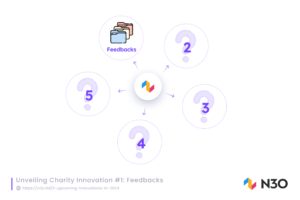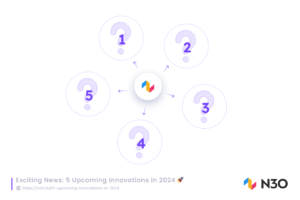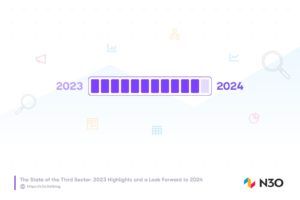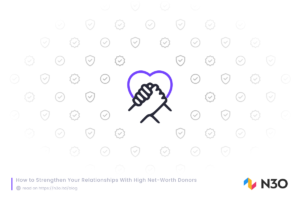It’s time to bid farewell to the closing chapters of 2023. At the same time, it is imperative to reflect upon the dynamic journey undertaken by the third sector throughout the year. The challenges faced, achievements celebrated, and lessons learned have collectively shaped the landscape of charitable organisations and continue to do so.
This article reflects on what 2023 was like for the third sector. Additionally, it delves into the opportunities and challenges faced by charities in 2024. These include the impact of global events, changes in funding landscapes, and evolving societal needs. Let’s explore these in detail!
Key Insights: How Was 2023 for the Third Sector – A Look Back
Below are some key insights from 2023 and how things went for charities and non-profits compared to projections for the ending year.
- Slowed growth: According to the Road Ahead 2023 insights published by the NCVO, post-Covid, the cost-of-living crises slowed the charity sector’s growth, posing challenges throughout the year. The cost of running voluntary organisations continued to rise with an ever-narrowing gap between income and expense.
- Increased Inflation: The Office for Budget Responsibility projected that inflation would reach its highest point in 40 years, with charities experiencing increased expenses and decreased incomes.
- Reduced Individual Giving: Individual giving was also projected to reduce. According to the CAF UK Giving 2023 report, more than 69% of people indicated they would need to cut their spending to help manage bills. Of these, 17% said they would likely cut their charitable donations. This involved a 5% decrease or complete cancellation of a regular charity donation and 10% opting not to make a one-time donation.
- Recruitment Challenges: Recruitment was a challenge, too, as 56% of employers in the charity sector said they faced difficulty filling vacancies. Key aspects of this challenge include low pay rates compared to other sectors, with a rise in pay not matching the increase in prices.
- Technology Adoption: According to the Charity Digital Skills Report 2023, more than half of charities (54%) face significant CRM challenges, and 33% find their fundraising database challenging. Charities also face a range of operational challenges with data, including collecting the right data and analysing it (both 39%). 26% find making the most of their CRM (including reporting) an issue.
- Increased Cyber Threats: As technology continues to evolve in fundraising and administrative operations, the risk of cyber fraud remains a persistent concern. According to the 2023 Cyber Security Breaches Survey by the Department of Science, Innovation & Technology, 24% of charities experienced a breach or attack in the past 12 months. Notably, high-income charities, with an annual income of £500,000 or more, faced a significantly higher percentage (56%) of cyber attacks.
- Policy Changes: In 2023, there have been notable developments in charity law, including the enactment of new legislation, court and tribunal rulings, and updated guidance from the Charity Commission. These include guidance on charity investment and social media. The same report emphasised that charities should be responsive to shifts in the political landscape. They need to adapt in light of the 2025 general election and newly introduced legal provisions impacting the sector.
- Public Trust in Charities: Public trust in the sector remains stable, though it has not fully recovered to pre-2015 levels. The legacy of governance issues in larger charities continues to affect trust. It renders crucial for organisations to demonstrate prudent fund management and a clear link between donations and impact. This is especially true for the less secure population, which is more inclined to trust smaller, local, and volunteer-run charities.
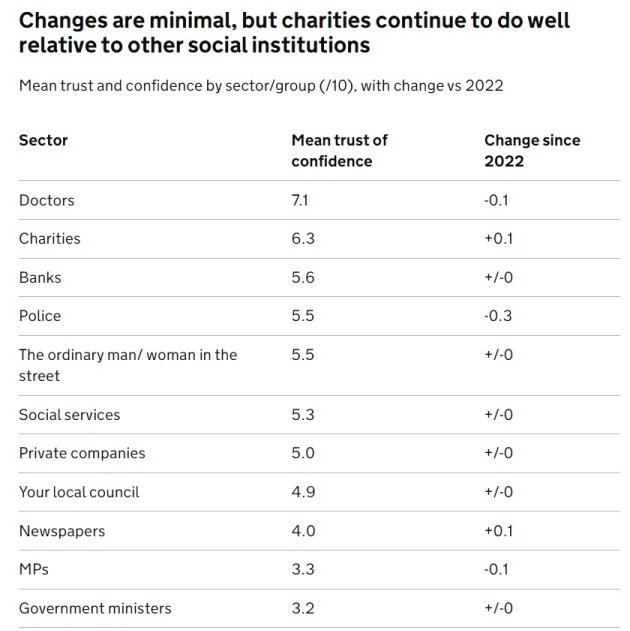
Charity Commission Public Trust Research
Research by the Charity Commission in April 2023 found that although trust levels are still lower than historical highs, public trust in charities has increased. Nevertheless, the improvement is small.
- Charities Embrace Tech: The Rewarding Industries 2023 report said that 63% of respondents in the third sector (charities) reported their organisations adopting new or different technology since the COVID-19 pandemic. Charities increasingly rely on technology to improve fundraising, enhance marketing efforts, and address talent gaps.
- Use of AI Tools: In the last 12 months, 58% of surveyed charities reported utilising the metaverse, Augmented Reality (AR), or Virtual Reality (VR), engaging in online games, or collaborating with gamification providers to inspire donations. Play Fund Win is a great example of a digital fundraising platform. It links charities and supporters by incorporating gamification, utilising technology to digitise raffles and prize draws.
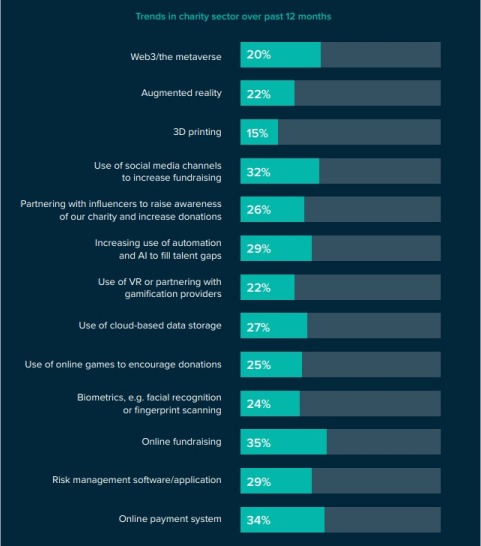
The Rewarding Industries 2023 Report
- Addressing Social Inequities: The Road Ahead report highlighted the persistent presence of workplace discrimination in the sector. It emphasised the need for charities to cultivate inclusive internal cultures. It also encouraged active advocacy for equity in government and across social media platforms.
- Talent Churn: The survey findings in the Rewarding Industries 2023 report reveal that 45% of charities experienced a rise in staff turnover. And 55% observed employees leaving the sector to pursue better-paying opportunities in alternative industries.
Challenges and Opportunities: What to Expect in 2024 – A Look Ahead
Charities can use insights from 2023 to address the challenges and opportunities on the horizon for 2024. Next, we explore the areas charities must focus on to continue to grow.
A Multi-Disciplinary Approach to Fundraising
Increasing fundraising in 2024 is crucial for charities to expand their impact and reach more beneficiaries. With that, Charities need to take a more personal approach with donors and avoid being over-reliant on one or two major sources of income. Below are some strategies to achieve this goal in 2024:
Diversify Funding Sources: Reduce dependence on a single funding source. Explore diverse fundraising models beyond traditional methods such as crowdfunding. Aim for grants, individual donations, corporate sponsorships, fee-for-service models, and social enterprises. Charities can seek collaborations and partnerships with businesses to pool resources, minimise costs, and enjoy additional revenue streams and financial sustainability.
The Sleep Charity and Furniture Village collaborated to launch the inaugural National Sleep Helpline in the UK. It aims to assist individuals facing sleep difficulties.
This collaboration proved immensely valuable, contributing a substantial £50k to The Sleep Charity, whose total income in 2021 approached £475K after its launch.
This co-branded helpline not only allowed Furniture Village to understand the sleep-related challenges of its customers better and enhance its offerings but also significantly increased brand awareness for The Sleep Charity. It continues to exemplify the impact of a meaningful partnership between a small charity and a corporate entity.
Such partnerships help both organisations achieve their goals and foster increased community support.
National Sleep Helpline – A Collaboration
Expand upon Virtual Fundraising: Use internet platforms and digital tools to solicit and collect donations for your cause. You can cost-effectively reach a global audience and engage them for charitable causes. Below are some ways you can implement online fundraising in 2024:
- Custom donation forms
- Peer-to-peer fundraising
- Recurring donations
- Online giving days
- Mobile-responsive giving
- Text messaging
- Matching gift drive
- Data-driven fundraising
- Crowdfunding
- Fundraising web store
The Rewarding Industries Report 2023
Influencer-Driven Fundraising: Charities are increasingly leveraging the reach and credibility of influencers to amplify awareness and engagement. When an influencer is aligned with a cause, it adds a personal touch and, more importantly, credibility. As a result, donors are more emotionally connected.
A successful example is the fundraising campaign for Action For Humanity by Zeshan Rehmani, “Emergency Appeal For Gaza”. The direct association between an influencer and a cause creates a powerful narrative that motivates people to contribute to fundraising.
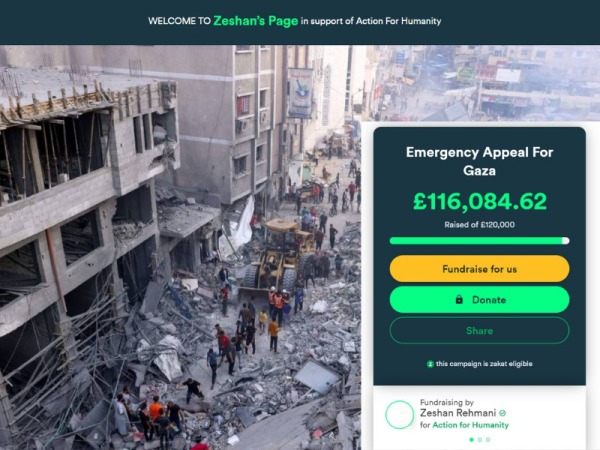
Action For Humanity Fundraising Campaign
Use Storytelling to Raise Funds: Charities can leverage engaging storytelling to raise funds. Storytelling helps in crafting compelling narratives that resonate emotionally with donors.
What type of stories should you promote? A recent study by Liang et al. (2016) showed how the positive emotion of strength could inspire people to donate to charity. Combining strength and the negative emotion of sadness (inspiration-helping hypothesis) leads to increased donations compared to strength-dominating and sadness-dominating appeals. In summary, presenting hope through a charity’s interventions will more likely induce people to donate.
Save the Children Success Story
A noteworthy example of a charity using this approach is Save the Children. It shares the story of a Liberian midwife, Alice, to inspire its supporters. Catching Alices employs interactive storytelling techniques using images, video, and quotes. Through this story, Save the Children shares its privilege of working alongside Alice to create a transformative impact. This article from Charity Digital is a good start to understanding how to incorporate storytelling in building a story around your cause.
Offer Flexible Giving: Empower regular donors with greater control with flexible giving. It allows monthly decisions on contributions, enabling adjustments based on individual financial situations. Digital payment specialists PayPoint found that 64% of donors desire the flexibility to modify monthly donations.
Charities offer yearly, quarterly, monthly and weekly giving to give people flexibility. At N3O, we’re soon to release our innovative ‘scheduled giving’ functionality. You can set dates as you wish throughout the year according to key periods of time and automate the regular giving donation process. Details will be released soon via our mailing list.
Unicef Children’s Charity illustrates an effective, flexible giving scheme where supporters receive monthly overviews and can choose to skip donations if needed. The autonomy granted to potential donors through flexible giving enhances sign-up rates. At the same time, it ensures regular donations are regularly captured, which provides greater visibility on financial sustainability than one-off donations.
Unicef Children’s Charity
Riding Economic Uncertainty
Economic fluctuations and global events will continue to impact donor contributions and funding availability. Charities should develop contingency plans to navigate financial challenges and sustain operations.
What can charities do about it?
In addition to increasing fundraising, charities can take several proactive measures to mitigate the impact of inflation in 2024:
Tighter Cost Management: Regularly review and optimise operational costs by renegotiating contracts, exploring bulk purchasing, and adopting cost-saving measures. Also, establishing and maintaining an additional reserve fund to navigate economic instability can provide a financial buffer during challenging times.
Implement flexible budgeting strategies to quickly adjust to changing financial circumstances through regular reviews and updates.
Embrace Technology: As highlighted above, charities faced challenges in 2023 and continue to struggle with their existing tech. This calls for an alternate approach to adopting systems. Systems that will improve their efficiency rather than add to the operational burden.
Leverage technology for fundraising, communication, accounting, and project management. These might look like big investments, but they reduce costs in the long term. Think hard before entering long multi-year contracts with vendors, especially for larger purchases such as CRMs and websites.
Explore innovative ways to deliver services, raise funds, and engage with the community.
Communication and Transparency: Maintain open communication with stakeholders to foster trust. Be transparent about financial challenges to encourage increased support. Improve donor engagement and retention, leverage social media, and employ personalised engagement strategies to maintain or increase donation levels. Find out how charities are using tech to revolutionise their communication.
Retain the Best Talent: Whilst some charities are seeing an increase in CVs submitted for open roles, many are struggling to fill roles with the right people. We have found that keeping and retaining the best talent is paramount for the effective functioning of charities.
Consider providing a hybrid working environment, increased flexibility and greater inclusion. To maximise efficiency, charities can consider cross-training staff, relying on skilled volunteers, and outsourcing non-core functions. Some charities are using AI to fill the talent gaps. Where necessary, charities can implement the following strategies to address the increasing staff turnover in the sector:
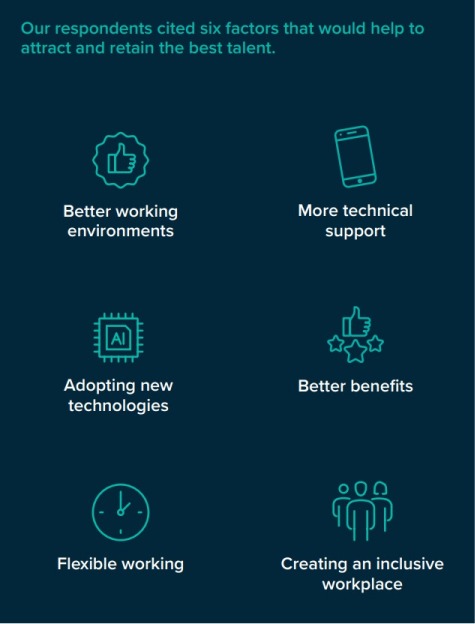
The Rewarding Industries Report 2023
Digital Innovation
Embrace technological advancements to enhance outreach, fundraising, and program delivery. Explore new digital platforms, virtual events, and innovative solutions to connect with supporters. Some developments to double down in 2024 include:
Online Fundraising Campaigns: Digital platforms for fundraising campaigns are growing exponentially in the sector. Crowdfunding, online donation portals, and social media are increasingly being used to reach a broader audience and increase donation participation. Host virtual events, workshops, and conferences to engage donors and supporters globally. These initiatives foster a sense of community and participation through online platforms.
Invest in Technology Built for Charities: More and more charities are finding it challenging to work with generic CRMs and databases like Salesforce, Dynamics, and Lamplight. It has become imperative for charities to be vigilant about the technology they invest in. Technology is increasingly essential, built explicitly for charities like the Engage CRM. We believe charity-specific CRMs outperform generic CRMs, and here’s why you should adopt them.
How does a Charity CRM add value to your Organisation
Data Analytics for Decision-Making: Utilize data analytics tools to gather insights into donor behaviour, optimise fundraising strategies, and make informed decisions on resource allocation. CRMs can help charities leverage donor data and understand their demographics to improve decision-making.
Blockchain for Transparency: Blockchain technology and integration for varied payment methods offers another tech advancement to charities. Implement blockchain technology to enhance transparency in financial transactions, ensuring donors clearly understand how their contributions are utilised.
Cloud-Based Tools: Embrace cloud-based tools like charity CRMs to facilitate remote work, streamline internal processes, and enhance communication among team members and stakeholders. Develop mobile applications to facilitate easy and accessible engagement. It provides a convenient way for donors to contribute and stay connected with the charity’s initiatives.
Artificial Intelligence, Virtual Reality, and Augmented Reality: Explore AI applications to personalise donor interactions. It can provide tailored content and communication to strengthen the connection between the charity and its supporters with tools like ChatGPT. Explore VR and AR applications to create immersive experiences that showcase the impact of donations. In the past year, 58% of surveyed charities reported utilising the metaverse. They mentioned using AR or VR, engaging in online games, or collaborating with gaming providers to encourage donations.
Saudi Arabian non-profit Al-Wedad Foundation for Development used AI to raise millions of dollars for orphans last Ramadan.
Secure Digital Infrastructure: As charities rely more on digital platforms, the risk of cybersecurity threats increases. Therefore, take the following actions to boost cyber resilience:
- Invest in cybersecurity training for employees
- Enforce strong password policies
- Implement thorough offboarding protocols to enhance organisational security
- Conduct regular cybersecurity audits
- Utilise encryption, firewalls, and intrusion detection systems
- Establish secure remote work practices
- Develop an incident response plan
- Implement regular backup procedures
- Assess the cybersecurity practices of third-party vendors to safeguard against potential threats.
The Cyber Security for Charities series by the Third Sector and NCSC highlights the importance of protection against cyber crimes and how charities can implement it.
The Future of Charities – Takeaways
Despite the challenges, the future for the third sector looks promising, with an ever-increasing value of social institutions like charities. However, for charities to thrive, they must adopt a proactive approach to dealing with increasing inflation, technological advancements, and meeting employee expectations. Among various strategies shared in this article, start with the ones that address the most pressing concerns of your charity.

